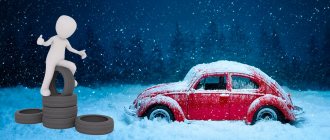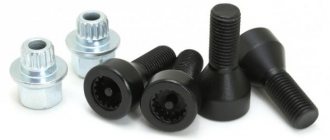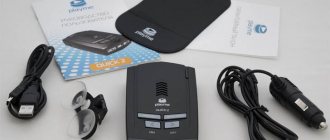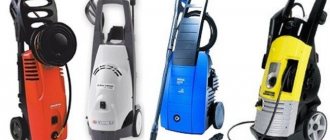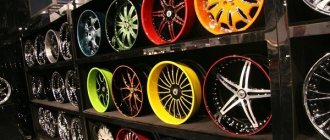How to choose winter tires
Choosing winter tires for a car is an extremely responsible matter, because the life of the driver himself and all the people around him sometimes depends on its quality.
The main criteria when choosing tires:
- Presence/absence of thorns.
- Character of the tread.
Which tires are better in winter: studs or Velcro? Studded tires are all strewn with medium-sized spikes that attach them to the road surface. Friction tires (colloquially called Velcro) have a large number of small slots in the lamellas. Due to them, such rubber sticks to the road surface. To decide on the choice of tires, consider their pros and cons:
- On clean asphalt, both perform equally well, but studded tires are noisier to use. The braking distance on wet asphalt is almost identical. On dry asphalt surfaces, Velcro behave a little better.
- At sub-zero temperatures on a clean track, studs are inferior to Velcro. Scientists conducted tests, during which it turned out that although the contact patch of studded tires is slightly smaller than that of friction ones, the handling of modern tires with studded tires does not suffer from this in any way. The braking distance of Velcro and studs on packed snow is almost the same.
- On urban slush (a mixture of snow, water and mud), velcro tires are more predictable and controllable. When driving on studded tires on such roads, you will have to slow down significantly.
- Studded tires cope well with icy conditions - acceleration and braking are noticeably faster than with Velcro. On winding, icy roads with sharp turns, studded tires are more controllable, predictable and safe.
- Long-term studies have shown that the use of studded tires increases fuel consumption during the winter season by two or three times more than with friction tires.
The tread depth for driving mainly on asphalt will be sufficient from 6 mm to 8 mm.
In this case, the tire tread pattern can be chosen directional to remove snow slush from under the contact patch of the wheels, or you can choose non-directional. Many car owners believe that on virgin snow, tires with large treads bury themselves. At the same time, they have a short braking distance on a snowy road.
For driving in snow, it is recommended to take tires with deep, high tread (about 10 mm) and an aggressive pattern. On slush and snowy roads, tires with a V-shaped tread pattern perform well. This pattern effectively combats the effect of aquaplaning (loss of traction between a wheel and the road surface on wet asphalt), removing all the dirt and mess from under the wheels.
The classic tread is preferable on dry asphalt and satisfactorily removes water from the contact patch with the road. The asymmetric tread pattern is the most compromise option between the other two patterns. Its disadvantage is that the combination process is not always successful, which can lead to unpredictable behavior of tires on slush, ice and snowy roads.
What to watch out for when buying winter tires
It’s not enough to know how to choose good winter tires for a car, because it’s also important not to be deceived. At the market, sellers immediately see who understands the product and who does not. Inexperienced drivers may be sold expired or defective tires, so check the expiration date and carefully examine the tires before purchasing.
After reading this article, even a novice driver will be able to independently choose winter tires for his car. If you still haven’t decided which winter tires are best to choose, reviews from experienced drivers will help you decide.
What is the difference between winter tires and summer tires?
Winter tires are intended for use when the temperature drops to +7 degrees. Differences between winter tires and summer tires:
- Higher density knurling (there are many more grooves on its tread).
- Wide central grooves (2 or 3 pcs.).
- Lamelization (5 times more lamellas on the surface).
- The tread pattern has a direction (for example, V-shaped).
- Asymmetrical pattern, divided by grooves (each sector has its own characteristics for improving road grip, etc.).
Characteristics of friction rubber, pros and cons
Winter friction tires should be selected based on the climatic conditions in which the car will be operated. The main task of this type of tire is to provide the best grip on wet or wet snow-covered roads.
The main distinguishing feature in choosing this type of rubber is the network of drainage grooves in the tire tread and high traction characteristics. From a huge assortment of manufacturer brands, which tires are best to buy is a question that perhaps every motorist asks. When choosing winter friction tires, in addition to the manufacturer's brand, special attention should be paid to the tread pattern.
According to the tests carried out, and as positive reviews from car owners show, a tire with a directional tread pattern is much better at removing water and dirt from under the wheel. Now it’s worth talking about the advantages of using this type of tire:
- Characteristics. Excellent performance when driving on wet and dry road surfaces.
- Comfort. The low noise produced by friction tires increases driving comfort.
- Road surface. While driving on such tires, the road surface does not deteriorate.
Along with the advantages, there is one disadvantage when choosing friction rubber - it is unsuitable for driving on icy roads, so the car will be difficult to control.
Cost of winter tires for a car
The price of winter tires varies greatly. The cost of studded tires starts from 1800 rubles (Tigar, Tunga, Amtel, etc.) and ends at around 14,000 - 15,000 rubles (Pirelli, NOKIAN, MICHELIN, Continental, etc.)
The price for Velcro tires varies from 1,600 rubles (Contyre, Dunlop, KingStar, etc.) to 15,000 rubles (NOKIAN, MICHELIN, Continental, Bridgestone, etc.).
The price of winter tires depends on their diameter (tires cost more if they have a larger diameter). Friction winter tires are considered the most expensive, since practice shows that cheap studded tires are sold of rather low quality - many studs fall off when driving (the rubber quickly becomes bald).
Some recommendations when choosing winter tires
Before choosing winter tires, there are a few tips you should know. For driving on snowy and icy roads, it is better to give preference to softer tires. You can also ride on bare asphalt with such a tire, but it will wear out faster; on such a surface it is better to ride on hard rubber.
It is quite difficult to determine this factor by touch; a sales consultant can help with this, or you can get information about a specific model by reading customer reviews on the Internet.
As practice shows, tires with an asymmetrical pattern on the wheel tread cope more effectively with car control in winter. The main thing is to install the tires correctly according to the marks on them. After mounting the tire, the mark should be located next to the nipple. By following these small tips when choosing a set of new tires, the motorist will protect himself and the car while driving in winter.
When to change summer tires to winter ones
If you have already decided which tires to choose for the winter, then there may be a misunderstanding about when to install them. Since childhood, every future driver knows that it is necessary to put winter tires on the wheels of the car only after snow has fallen.
Contrary to popular belief, it is better to change summer tires to winter ones when the weather forecast does not promise temperatures above 7 degrees. Summer tires are extremely ineffective not only in winter, on frozen asphalt, but also on any road at +7. This suggests that it is worth changing the tires even before the general rush in tire shops begins.
Everyone needs to know this: the composition and price of a car first aid kit in Russia since 2015.
What the fine for tinting is from September 1, 2020, we tell you here.
Selection of windshield wiper blades for your car: https://avto-femida.ru/driver/useful/avtomobilnyie-shhetki-stekloochistitelya.html
Characteristics of Scandinavian rubber
Scandinavian tires are designed for driving on heavily snowy roads. In those regions where there is a huge amount of snow, this type of tire should be purchased for the winter. In addition to high cross-country ability in snowy regions, reviews from car owners also show that this tire copes with its task. The advantages and disadvantages of using Scandinavian rubber are the same as those of friction rubber.
Which winter tires to choose (studded, non-studded or Scandinavian) is a question that depends on many factors: the climatic conditions in which the car will be driven, the driver’s driving style, speed limit, and others. So there is no clear answer as to which tires are better. Before choosing a set of car tires for the winter, you should pay attention to these factors. There are some recommendations for choosing tires, which will be discussed below.
What to look for when choosing winter tires
When choosing tires for winter use, you should pay attention to a number of points. First of all, this is the production date. It would be correct to use tires whose release date is no older than 2-3 years. Otherwise, you risk purchasing tires whose rubber compound has lost its quality and cannot ensure safe driving, especially in winter.
The cost of tires also plays a big role in the choice. We recommend not to choose tires that are too cheap, as this will compromise the quality. If you have a budget car, this does not mean that choosing budget tires is enough. We advise you to pay attention to the optimal price-quality ratio.
We also recommend looking at the appearance of the tires. If stored incorrectly, they may become deformed and not provide safe movement. Important parameters are speed and load indices, depending on the type of car for which tires are selected.
Naturally, an important parameter is the tire size. In this direction, it is necessary to focus on the recommendations of the car manufacturer. We do not recommend choosing tires that are much larger.
The pattern type for studless tires is Scandinavian and European. In the first case, the pattern consists of diamonds and rectangles, which are placed on the tire in a checkerboard pattern. In addition, there are powerful lugs. Tires with a Scandinavian pattern are recommended for use on icy or snowy surfaces; they provide the car with maximum stability. The European pattern is similar in nature to a summer rain tire. There is a whole network of channels along the entire surface, as well as many lamellas. In winter, such tires are actively used on cleared roads, in which case they have proven themselves to be excellent.
You have received brief information on how to choose the right tires for driving in winter conditions. The main thing to remember is that you should choose tires taking into account the driving characteristics, as well as the typical weather for your region.
Another feature of choosing tires for winter use is their width. Many people wonder which set the car will perform better on, narrow or wide. In this case, the correct choice will be depending on the type of surface on which the car is supposed to be used. Dense cover (packed snow or ice) is an ideal place for narrow tires:
- greater specific pressure on the surface provides the car with stability and controllability;
- On a slippery surface, narrow tires are of little use; a wide tire better grips a slippery road covered with water or melted snow.
The situation is similar with car braking - on ice, a wide wheel brakes better, on dense snow - a narrow one. Therefore, the choice in this case depends on the type of road surface. It is worth considering that the adhesion coefficient is affected not only by the width of the rubber, but also by the tread pattern, type of snow cover (loose, dense, dry, wet) and air temperature.
By the way, another tip concerns the height of the profile - in winter a high profile is more effective, it allows you to dampen shocks.
Winter non-studded tires
In the European part of Russia, winter is not constant. After severe frosts, prolonged thaws may come, there may be rain on New Year’s Eve, and the snow may melt in February. Therefore, when choosing tires for the winter, motorists will give preference to non-studded wheels.
The Scandinavian version of winter tires becomes an ideal option for Russian conditions. Excellent traction with the road surface is ensured by a thin tread pattern, which consists of diamonds and rectangles.
The main advantages of studless tires look like this:
- excellent parameters for moving on asphalt (dry or wet);
- maintaining its parameters during operation in warm weather;
- minimal increase in noise level;
- “careful attitude” towards asphalt roads.
The main disadvantage of studless tires is their unsuitability for driving on roads covered with ice.
Life time
Winter tires are used on average for 2-4 seasons. Their service life is affected by weather, road conditions, driving style and much more. If you want your winter tires to last longer, avoid accelerating or braking too hard at high speeds or driving very close to curbs. The condition of the tires is also affected by vehicle overload; this factor can reduce the service life of winter tires by almost half.
Choose winter tires
Alena Russiyanova, Trade portal Shop.by
Dunlop tire reviews
The brand is well popularized, which allows its products to regularly take places in the first positions in sales. Users value these tires for their stable, although not premium, but optimal quality, almost always impeccable performance properties of the rubber compound, as well as increased wear resistance.
Now it’s worth taking a closer look at the question of how to choose winter tires for your car. Reviews of the latest series put the Blizzak Spike model in first place. Features of the modification include the presence of a V-shaped directional pattern, as well as an increased number of lamellas with a modified shape of cross grooves. In practice, these qualities contribute to the effective removal of snow-water slurry from the contact spot.
This manufacturer is less known, but the quality of the tires produced deserves attention. The company's success is largely due to its specialization. The manufacturer places special emphasis on developing tires for the SUV segment, that is, the target audience, one might say, is formed by crossover owners. According to them, the tires cope with high loads without losing their primary grip qualities.
When deciding how to choose winter tires for a car from Dunlop’s offerings, you should be guided by the requirements for braking performance. This characteristic is the main factor by which products within the family differ. In general, the advantages of this manufacturer’s products include a well-thought-out rubber mixture, optimal rolling resistance and, at the same time, low cost.
The South Korean brand became famous for its successful studless model for the WinterCraft series passenger car. The developers did not stop there, and quite recently the WS31 modification, intended for the crossover segment, was released. Car owners of Kumho tires note a specific rubber composition with increased rigidity in the tread blocks.
Therefore, if the question of how to choose winter tires for a car under severe ice conditions is being decided, then this option will suit both SUV drivers and car owners. Driving practice confirms decent handling performance and, most importantly, confident braking on ice.
Finnish products need no introduction. Nokian is one of the largest manufacturers of winter tires, logically focused on the characteristics of the Scandinavian type. But, of course, the European class is also widely represented in the line of this brand.
For example, modifications WR A3-A4 are considered by experts as perhaps the best tires for winter in the category of non-studded models. Car owners point out the increased wear resistance of this rubber, as well as confidence when driving on snow.
This company is also a recognized leader in tire production. The concern owns several brands covering different segments. For example, the Kleber brand offers a mid-range range. We can say that this is close to the budget class, but users of this product praise it for its pronounced qualities of a reliable tread with an aggressive pattern.
Tire sipes, what they are, what shape the sipes have
Sipes can be considered the main element of winter tires. With the help of these narrow sipes in the tire tread, excellent stability of the vehicle and its excellent driving characteristics on snow-covered bad roads are guaranteed.
The shape of the lamellas can be very different, for example, lamellas with a wave-like shape are able to maintain their flexibility in virtually any road and weather conditions, which gives them the opportunity to crash deep into the snow and not lose stability on icy roads.
Sinusoidal lamellas provide the vehicle with decent lateral stability, while zigzag lamellas make it possible to better maneuver with the help of pointed edges. Three-dimensional or, as they are also called, 3D sipes have internal supports, thanks to which the pressure on the tread is more uniform and improves traction.
Regardless of the type of lamellas, their operating principle is the same - adhesion of snow to snow. In other words, when the vehicle starts moving, with the help of sipes, winter tires eat deeply into the layer of snow and seem to “rakes” it under themselves, pushing a new portion of snow out of the contact patch.
On ice, the sipes are able to expand at the point of contact between the tire and the road, causing excessive stress on the edges of the sipes, and the pressure prevents the tires from slipping when driving. In addition, due to the frictional force that arises, frictional heat appears at the point of contact, which contributes to the melting of the ice and the formation of a thin layer of water on its surface.
There are three classes of winter tires - friction, studded and studded. If winter tires are studded, the tread will be the most rigid, which is necessary for reliable fastening of metal studs in the rubber body.
